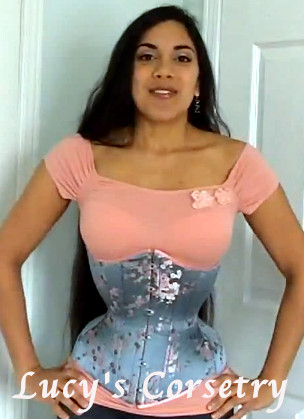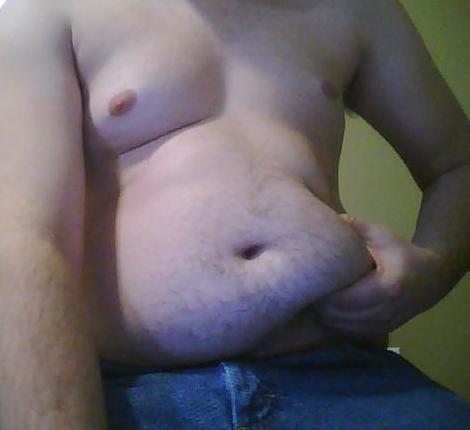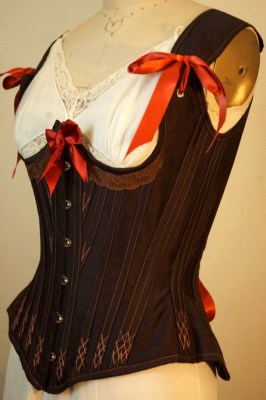
Over the past little over a year, I reviewed a whopping nine different mesh corsets, and many of them had very different types of mesh (different fibers, weaves, stretchiness and quality), and not all mesh corsets are made equal! It can be a little different to tell them apart on video and confusing when there are so many different terms, so let’s go through the most popular types of mesh for corsets and discuss the pros and cons for each one.
Fishnet

Featured in my past reviews:
- Orchard Corset: CS-201, CS-411, CS-426 underbusts; CS-511 overbust
- Mystic City: MCC-64 (old stock)
- Glamorous Corset: Bella cincher, Emma underbust, and Jolie longline.
This is a very open type netting made with cotton or polyester – it looks a bit like string or yarn twisted or knotted together. It is very flexible, can be a bit stretchy, and usually has a hexagonal shape to it. (As we know from nature, hexagons maximize the area inside each hole while minimizing the materials used for each wall – so the fishnet can cover a large surface area while not using much fabric to do so.)
Pros: fishnet is probably the coolest and breeziest type of mesh, and it comes in many different colors – Mystic City used to sell these with red mesh, blue, orange, green, etc. Orchard Corset regularly keeps these stocked in black and tan (and sometimes white), with occasional limited colors like red, gold, and navy blue. This is the most ubiquitous type of mesh corset, so it’s easy to find.
Cons: this fabric has a lot of give and definitely stretches out over time. Because there’s technically only a few threads holding in each bit of the fishnet within the seams, it can rip over time.
(I don’t know whether you call it a pro or a con, but the net leaves temporary impressions in your skin so when you take off the corset it looks like you have lizard scales. It looks cool but can feel rather itchy.)

A slightly more tight-knit version of fishnet is used in Brazil, and I noticed that their mesh corsets have smaller, square shaped holes instead of hexagonal – I feel that this might work better for corsets as it has a clear warp and weft to follow.
My Madame Sher mesh cincher is still holding up very well and I’ve worn it every summer for the past 4 years. It can still show a little damage over time, due to the nature of the fabric, but I’ve been pleasantly surprised by its longevity.
Corsetry mesh
Featured in my past reviews:

I believe that the newer stock of Mystic City corsets also use this mesh, and this is becoming probably the standard in many custom corsets.
Corsetry mesh is a synthetic fine woven net. It is fairly stiff and slightly reminiscent of the fly screens that you would see on windows and doors (except this is polyester/ nylon, and not aluminum or fiberglass which real window screens are made from).
Pros: corsetry mesh is smoother, stronger, and less likely to warp with wear. You can somewhat achieve a more conical rib with this type of fabric, but I’ve found that it still has relatively more give compared to more rigid, multi-layer cotton corsets.
Cons: this mesh is not as breathable as the holes are smaller (and it’s a synthetic fabric so it can feel plasticky). It can occasionally rip (usually if the seam allowances are not wide enough and it pulls from the stitching. Also, this type of mesh can be quite pokey. If any seam allowances do end up poking into the body, these threads can be snipped off with nail clippers and the rest pushed back under the fabric.
Tips for corset makers on reducing the “pokey” seams while using this type of mesh:
- Some makers if they’re very particular, they might melt the seams with a small flame or a hotknife, but this can also risk warping the mesh from the heat.
- Another simple way around this is by sewing the corset with the seam allowances on the outside of the corset (facing away from the body) and putting thick boning channels overtop so they won’t poke through.
- Vanyanis uses a plush velvet ribbon on the inside to further protect from any pokiness, and she taught Timeless Trends this finishing technique as well when she styled their OTR mesh corsets.
Bobbinet
Featured in none of my previous corset reviews.

Bobbinet is almost exclusively used in custom corsets by specialist corsetieres, for very lightweight corsets and foundationwear under couture dresses. It’s been used by designers like Crikey Aphrodite, Morúa Designs, Sew Curvy Couture, Laurie Tavan, Karolina Laskowska, Crimson Rose Corsetry, Ivy Rose Designs, etc.
It’s made from cool and breathable cotton – it flows well over curves and is super lightweight. It has a lot of give, and as such it’s often used in a double layer for extra strength (and a bit more opacity if desired). Because it’s cotton, it can also be dyed – but it’s such a delicate fabric that I wouldn’t train in this. You’re not likely to see this used in OTR corsets.
Tips for corset makers: Ivy Rose Designs made a tutorial on working with bobbinet for Foundations Revealed. If you’re not an FR member and you would like to become one, please use my referral link (there’s no difference in price).
Aida cloth (or Java mesh)
Featured in none of my previous corset reviews.

Aida cloth is less well known, not used in OTR, but some corsetieres have experimented with this for custom corsets, like The Bad Button and Bridges on the Body.
When you look at mesh corsets in the Victorian and Edwardian periods (e.g. their activewear corsets while playing tennis, or the corsets used by British women during the colonialization of India and other places of warmer climates), the mesh they used sometimes looked similar to this. Aida cloth is intended for cross stitching and comes in various weights and counts, so not all Aida cloth is made equal.
Pros: Aida cloth is cotton, so it’s a natural, breathable and cool fiber, and it can also be custom dyed.
Cons: Aida cloth can be difficult to source, and can also fray and shred.
Tips for corset makers: The Bad Button made a tutorial on working with Aida cloth on Foundations Revealed. If you’re not an FR member and you would like to become one, please use my referral link (there’s no difference in price).
Tulle
Featured in my past review: Contessa Gothique semi-mesh sweetheart underbust

This is a beautiful lightweight fabric (think of the stiff tulle you’d find in crinolines / underskirts), but better suited as a semi-mesh corset with plenty of reinforcement. The tulle in this corset is limited to relatively straight panels (not super curvy ones), and the tulle is flanked on all sides – bones on either side (as well as the center of the panel), and even the binding at top and bottom is coutil to prevent stretch or warping.
The waist tape also takes the tension at the waistline, so the tulle is mainly just preventing the flesh from bubbling out of the “windows” but it’s not contributing to the actual reduction of the waist in a significant way.
Pros: it’s pretty, easily sourced, and comes in almost any color imaginable.
Cons: I think if it were forced to take more of the tension, it might risk tearing. The tulle makes for a lovely and delicate look – but I wouldn’t use this for everyday intense training.
Sports mesh
Featured in my past review: JL Corsets / Sultry Confinement “Christine” underbust

This (I’ve been told) is also the type of mesh used by Restyle for their mesh CU underbust, and I think Mystic City has experimented with this in limited styles as well.
Sports mesh is also known as athletic mesh, tricot fabric, or (especially in the US) “football fabric”. This type of fabric is what’s often used in shoes and team jerseys, and also the non-stretch mesh pockets found in luggage and schoolbags, as well as non-stretch mesh laundry bags and gear sacks. It’s made from polyester and can come in a rainbow of colors.
While it may look similar to fishnet at first glance, it behaves very differently – it has little to no give or stretch, and the holes look more circular (or sometimes square), as if they were ‘punched’ out of the fabric (this is what gives it its tricot look) – however, if the holes were really punched out, this would weaken the fabric. Where fishnet looks like the ‘yarn’ is the same width everywhere, the sports mesh will have areas that look thicker and thinner – many of them have an almost ‘checkerboard’ appearance.
It’s a bit difficult to find the right type of sports mesh online, even when trying to use the correct terms and definitions, as fabric sellers on Ebay, Etsy and Alibaba will often use long strings of vaguely related words. If I can find a reliable source for this fabric in many colors, I’ll link it here, but I recommend going to a local fabric store and testing the stretch out for yourself – the right type of mesh should have little to no stretch, whereas fishnet is designed to stretch and give.
But the sports mesh costs only maybe $2 more per yard than the fishnet (therefore costs $1 more per underbust corset, depending on the size), and it comes in as many colors, for better quality and strength – so I would encourage more OTR corset manufacturers to test this fabric.
Pros: Imagine all the pros of fishnet without the cons. Sports mesh has bigger holes more on par with fishnet, so it’s more breathable than the corsetry mesh (which is a “plasticky” feeling fabric). It also doesn’t stretch out or warp as easily as fishnet. Sports mesh can come in a huge range of colors, as JL Corsets demonstrated with the corset to the right.
Cons: while sports mesh is stronger than fishnet, it’s not invincible – where there are holes, there is the risk of it catching on something and damaging the fabric. Also, while I actually prefer sports mesh compared to the fishnet, but I suppose because of the sports connotation some people might think it’s less cute than the fishnet.
Heavy Duty outdoor mesh
Featured in my past review: Contour Corset summer mesh underbust

This is a heavy duty mesh, similar to synthetic outdoor upholstery mesh. The only thing I can compare this to is the type of fabric you’d find on deck chairs or boat seats, but to this day I have not sourced the exact same fabric that Contour Corsets used to use.
Pros: this heavy duty mesh is the strongest type of mesh in this list, and comes in a rainbow of colors (in the video above I showed my gold corset, Strait-Laced Dame has a metallic silver and purple corset, and the one to the right shows the sky blue option).
Cons: this mesh is difficult to wear against the skin, absolutely requires a liner but I pretty much always wear a liner anyway. It takes a long time to form over curves, Fran said that the break-in process for one of her corsets lasted up to 100 hours of wear.
Powermesh
Featured in my past case study: Homemade Sport Powermesh “Corset”

One of the corsetieres who made this famous for corsets and corset girdles is Sian Hoffman. Also Morgana Femme Couture makes an overbust option (shown right) and an underbust option as well.
This is specifically designed to have stretch and give, with mild compression – it has spandex in it. You’d find this more in Merry Widows and girdles as opposed to “real” corsets. However, it has its uses (especially those who love a strong cinch combined with maximum mobility).
The rough version of a powermesh corset I made for myself featured satin coutil front and back, boning channels and diamond waist tap – but never finished the binding on it (it means I can wear it under my clothes and it creates a surprisingly smooth line – and this mesh doesn’t really fray as it’s a knit).
Pros: it makes a very flexible and comfy corset, allowing you a lot of movement.
Cons: are that although it is still a single layer corset, because it’s a finely-woven synthetic material, it can get a little warm compared to the other types of mesh. This corset will definitely not give you a conical ribcage, as it stretches around every natural curve of your body. Also, the bones a not placed relatively close together, there is a risk of parts of the corset shrinking or rolling up in places (which is why it’s most often used in girdles, where the garter straps / suspenders keep it pulled down and smooth).
These are the most popular types of mesh and net used in corsets, but if you’d like to see even more examples of mesh, sheer, and summer corsets, (including some made from lace, organza, and horsehair), I have a whole gallery over on this permanent page! Do you know of other types of mesh that are used for corsets that I didn’t mention here or in the gallery? Comment below and let us know.






















































